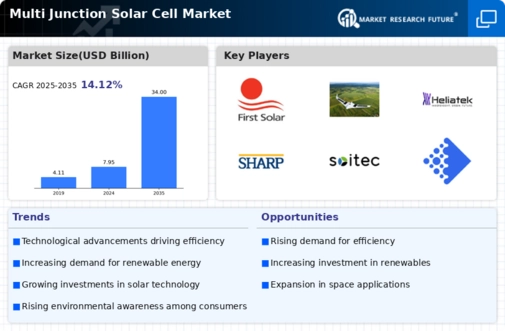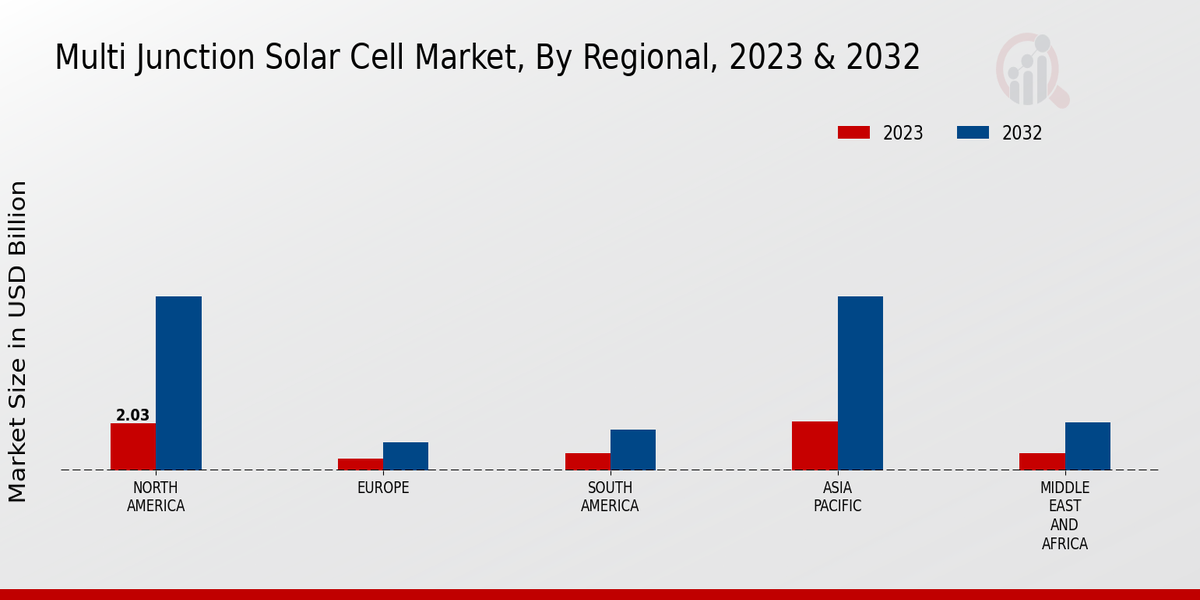Rising Energy Demand
The increasing global energy demand is a significant driver of the Global Multi Junction Solar Cell Market Industry. As populations grow and economies develop, the need for sustainable energy solutions becomes more pressing. Multi-junction solar cells, known for their high efficiency, are well-positioned to meet this demand. For example, regions with abundant sunlight, such as the Middle East and North Africa, are increasingly adopting these technologies to harness solar energy effectively. This trend is likely to contribute to a compound annual growth rate of 14.12% from 2025 to 2035, highlighting the market's potential to address energy needs sustainably.
Market Growth Projections
The Global Multi Junction Solar Cell Market Industry is projected to experience substantial growth over the coming years. With an estimated market value of 7.95 USD Billion in 2024, the industry is expected to expand significantly, reaching 34.0 USD Billion by 2035. This growth trajectory indicates a compound annual growth rate of 14.12% from 2025 to 2035. Such projections reflect the increasing adoption of multi-junction solar cells across various sectors, driven by technological advancements, government support, and rising energy demands. The market's potential appears robust, suggesting a promising future for multi-junction solar technologies.
Technological Advancements
The Global Multi Junction Solar Cell Market Industry is experiencing rapid technological advancements that enhance efficiency and performance. Innovations in materials, such as the use of perovskite layers, are being integrated into multi-junction designs, potentially increasing energy conversion rates beyond 40 percent. These advancements not only improve the overall efficiency of solar cells but also reduce the cost per watt, making solar energy more competitive with traditional energy sources. As a result, the market is projected to grow significantly, with an estimated value of 7.95 USD Billion in 2024, indicating a strong demand for cutting-edge solar technologies.
Government Incentives and Policies
Government incentives and supportive policies play a crucial role in driving the Global Multi Junction Solar Cell Market Industry. Many countries are implementing favorable regulations, tax credits, and subsidies to promote renewable energy adoption. For instance, the United States has introduced various programs aimed at increasing solar energy capacity, which directly benefits multi-junction solar cell technologies. These initiatives not only encourage investment in solar infrastructure but also create a conducive environment for market growth. As a result, the market is expected to expand, with projections indicating a value of 34.0 USD Billion by 2035, reflecting the positive impact of government support.
Market Diversification and Applications
The Global Multi Junction Solar Cell Market Industry is witnessing diversification in applications, which is driving its growth. Multi-junction solar cells are not only utilized in traditional solar panels but are also finding applications in aerospace, satellites, and concentrated solar power systems. This versatility allows for broader market penetration and increased demand across various sectors. For instance, the aerospace industry is increasingly relying on high-efficiency solar cells for satellite power systems, which enhances the overall market potential. As applications expand, the market is likely to see sustained growth, supported by the unique advantages of multi-junction technologies.
Environmental Concerns and Sustainability
Growing environmental concerns and the push for sustainability are pivotal factors influencing the Global Multi Junction Solar Cell Market Industry. As climate change becomes an urgent global issue, there is a heightened focus on reducing carbon emissions and transitioning to renewable energy sources. Multi-junction solar cells offer a viable solution by providing efficient energy generation with a lower environmental footprint. Countries are increasingly committing to carbon neutrality goals, further driving the adoption of solar technologies. This shift towards sustainable energy solutions is expected to bolster market growth, as consumers and businesses alike prioritize environmentally friendly options.





















Leave a Comment